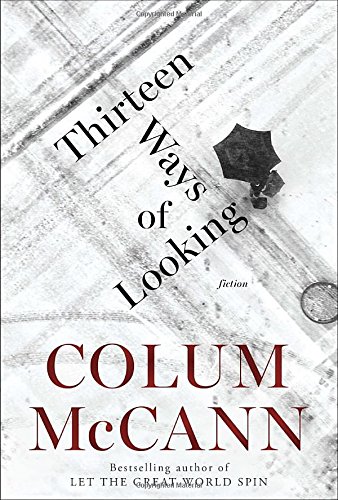Thirteen Ways of Looking
by Colum McCann
reviewed by Ophelia John
Right from the title story/novella, “Thirteen Ways of Looking,” with the stanzas of the Wallace Stevens poem as its chapter epigraphs, Colum McCann immerses the reader in a prose that acknowledges all the senses, yet best loves the sound of words. McCann, an acknowledged luminary of contemporary fiction (winner of the National Book Award, the International Dublin IMPAC Award, and the Chevalier des Arts et des Lettres, among many others), has also written about his own experience of violence, a theme central to this story collection.
In the title story, we meet P. J. Mendelssohn, a Jewish New Yorker by way of Poland and Ireland; his late wife, Eileen, and her Irish phrases (“don’t put all your begs in one ask-it”); and several other characters who bring the accents and words of their native places to this New York hymn. Sally from Tobago “speaks with bright coins in her voice. A tambourine in her throat. She swallowed a bird, Sally James, the first of the morning.” Here are ripples of Daisy from The Great Gatsby, a woman whose voice “is full of money,” but McCann’s meaning is musical rather than interpretive.
Sally is the live-in aide to Mendelssohn, the “mongrel really, a true New Yorker, in a city where people never knew how to die.” He is elderly, diapered every night, but still quite alive, keeping his thoughts and humor back from the “dark dogs of the mind” until the snowy day when he meets his unpleasant son for lunch and is killed, unseen, on the sidewalk by a blow from a stranger.
The story opens with a cryptic line: “The first is hidden high in a mahogany bookcase,” and ends with “More cameras in the city than birds in the sky.” The presence of security and/or television cameras, as well as the watching eyes of others (and a contemporary mix of languages and homelands), feature in two of the other stories in this volume, “Sh’kol” and “Treaty.” “Thirteen Ways” and “Treaty” both explore violence—not only the unanswerable why of it, but also the possibility of grace rather than revenge.
In “Treaty,” an Irish-born nun, Beverly, exposes her scarred breast in a London sandwich shop to the Colombian guerilla-turned-diplomat who kidnapped, raped, and tortured her thirty-seven years earlier. Before leaving the shop, she asks the Pakistani shopkeeper to give her the tapes from the security camera. He answers, “’There’s no actual tapes. I can’t give them to you … But nobody will see them, I promise you.’ … It is, she recognizes, an agreement of faith with a man whose name she does not even know.”
The outlier in the collection is the meta-story “What Time Is It Now, Where You Are.” Nominally about a young US soldier holding a satellite phone on New Year’s Eve in a place where there are no cameras, the actual plot is the trail of a writer’s process (the name of those Afghani mountains, the age of the protagonist’s son, the cold dry wind!). Here violence exists as setting, inextricable from the soldier at her post, rather than arriving as a moment or an event. Its masterful details linger in the mind: “Out beyond the outpost, nothing but the dark and the white frost on the land. The stars themselves like bulletholes above her” (and here again we enter the echo chamber of literature, calling up Sylvia Plath’s night sky, “Blueblack, with the much-poked periods of stars”).
For three months after first reading Thirteen Ways of Looking, I kept returning to one particular scene. Why, in the interrogation room of the title story, did the Dominican-American detective, Carla, and the Costa Rican murder suspect, Pedro, call each other “Papi” and “Mami”? Those diminutives mean different things from Puerto Rico to Patagonia, from “Daddy” and “Mommy” to “hey, baby,” but they’re always, always familiar. Never what a quiet, reserved suspect (first to say “Mami”) might say to a detective. Had McCann’s research misled him, or was he riffing off conversations overheard on the street? Is Pedro trying for sympathy? Power? Yet Carla responds in kind. The interrogation begins in Spanish and switches quickly to English. The dialogue is unpunctuated, the two speakers jammed together, sentences paced like water accelerating around the drain:
So what’s the problem? No problem, Papi. Then what am I doing here? You know the Barner Funds? The what? Maria was working for the Barner Funds. Yeah, what about it? What do you think of the Barner Funds? She had a good job, she liked it there, that’s all. That’s all? That’s it. It didn’t piss you off, Pedro? No, why should it? Even when she got fired?
Then comes one line that makes it all clear, turning what might have been a surface application of flavoring on the character’s voices into the real thing:
Maybe he was whispering sweet nothings. I never heard of him before. Maybe the jury’ll buy that story, Pedro? What story? You being a father and all, you punched his father? I didn’t punch no one. Are you sure about that, Pedro? I swear to God, Mami. You can call me Carla. I didn’t punch no one. Maybe you didn’t mean to hit him so hard, just an accident, like? I told you, I didn’t touch him. Maybe pushed him over? No. You want that glass of water now?
“You can call me Carla,” she says after he calls her “Mami” for the fourth time, and the subtext takes over. She threw him familiarity like a life preserver and then, as he reached for it, yanked it away. Thirteen Ways of Looking is visually titled and themed, but its voices are a pure treat for the ear.
Published on August 18, 2016

